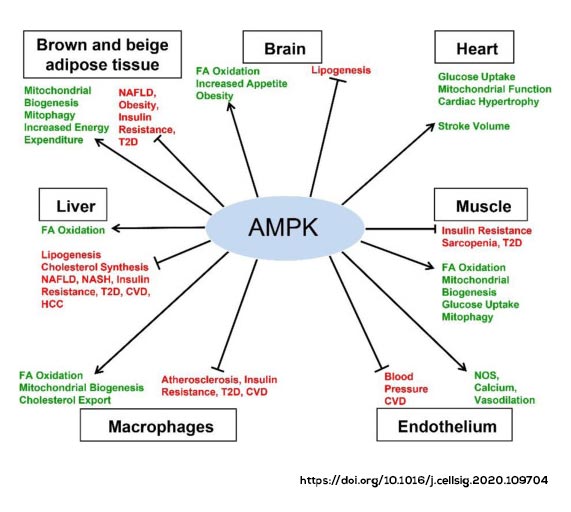“The AMP-Activated Protein Kinase”:
In the body, cells constantly manage their energy consumption in response to nutrient availability and ATP production capacity. The metabolic processes ensure the adequate production and utilization of energy. Catabolic processes such as the breakdown of glucose or lipids produce ATP, and the majority of ATP production in cells occurs in mitochondria, which are sites of oxidative phosphorylation. When cells use the stored energy for various cellular processes, ATP is broken down into ADP, which can then be converted to AMP. When cellular ATP levels fall, cells must reduce their energy consumption to avoid depleting their remaining resources. Simultaneously, emergency measures must be implemented to restore cellular energy supply, such as increasing nutrient intake and activating alternative energy-producing pathways. In our body, such processes are regulated by some important protein kinases and the key player in this system is AMP-activated protein kinase (AMPK). An article published in “Nature Reviews Molecular Cell Biology” referred, to AMPK as the “Guardian of Metabolism and Mitochondrial Homeostasis”. AMPK is also considered a “Metabolic Master Switch of the Body” and some researchers also denote it as a metabolic 'magic bullet' protein.
Functions of AMPK

AMPK is a Metabolic Master Switch of the Body for some reason as it is essential in controlling mitochondrial health and plays an integral role in energy homeostasis. With increased energy
demands while exercising and energy-deprived conditions such as starvation, and hypoxia (deficiency in the amount of oxygen delivered to the body tissues), AMPK regulates energy flow. AMPK increases energy production by stimulating catabolism and reducing energy consumption by inhibiting anabolism. The metabolic targets of AMPK are as follow:
To produce energy AMPK stimulates catabolic pathways and
· Stimulates glucose utilization by increasing glucose uptake into cells
· Pushes cells towards using their lipid stores
· Regulates lipid homeostasis
· Promotes mitochondrial biogenesis
To preserve energy AMPK inhibits anabolic pathways such as:
· Suppresses ribosomal protein synthesis
· Reduces lipid synthesis
· Prevents glycogenesis and gluconeogenesis.
Over the last decade, extensive research has revealed a variety of molecular mechanisms and physiological conditions that regulate AMPK activity. AMPK controls a variety of metabolic and physiological cascades; however, it is dysregulated in major chronic diseases such as obesity, inflammation, diabetes mellitus, and cancer. These chronic pathological conditions can suppress the activity of AMPK, consequently, cells suffer from its physiological functions because of underlying overexpression of reactive oxygen species, increased oxidative stress, inflammation, apoptosis, and impaired autophagy. AMPK activation has been very helpful in various disease domains like diabetes mellitus, liver diseases, chronic kidney diseases, etc. The AMPK activation has been demonstrated to ameliorate multiple components of metabolic syndrome by regulating a balance between anabolic and catabolic cellular reactions. Therefore, AMPK activation remains a key target link in the management of diseases in a natural way. Based on the available scientific literature, we have summarized below several herbs that have shown AMPK activation as a therapeutic approach:
Nigella sativa (Ranzmculaceae) possesses antihyperglycaemic, antihyperlipidemic, anti-inflammatory, antioxidant, etc through activation of the AMPK pathway. It has also been reported to control liver marker enzymes alleviates disease progression.
Trigonella faenum graecum (Leguminosae) reverses insulin resistance by the activation of the AMPK pathway and improves insulin sensitivity by promoting mitochondrial biogenesis.
Chichorium intybus (Compositae) via AMPK activation significantly attenuates the non-alcoholic fatty liver disease (NAFLD) and promotes liver functions.
Berberis aristata (Berberidaceae) improves glucose-lipid metabolism in the liver and also exerts AMPK mediated antihyperglycaemic, cardioprotective and hypolipidemic actions
Glycyrrhiza glabra (Fabaceae): Through AMPK activation, licorice the active phytoconstituent of G. glabra inhibits the activity and/or expression of lipogenic genes, including those of acetyl coenzyme A (CoA) carboxylase (ACC), fatty acid synthase (FAS), stearoyl-CoA desaturase 1 (SCD), and sterol regulatory element-binding protein 1 (SREBP1). Thus, influences the activity of various endocrine hormones, such as insulin, glucagon, and leptin in the body.
A plethora of scientific evidence suggest that herbs such as Ocimum sanctum, Tinospora cordiofolia, etc, have the ability to improre cellular bioenergetics in natural way by activating AMPK upregulation. Therefore, herbal formulations can be used in the therapeutic avenue by keeping their ability to activate AMPK upregulation in mind.


